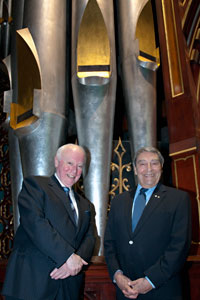Organ City, Organ Contest by Crystal Chan
/ October 1, 2011
Version française...
Flash version here.
The
only international organ competition in the Americas
 The Canadian International
Organ Competition: this homegrown triannual event is still the only
international organ competition in the Americas since it first started
in 2008. This fall marks the second edition of the CIOC, and it has
since gained an even bigger reputation for itself. The Canadian International
Organ Competition: this homegrown triannual event is still the only
international organ competition in the Americas since it first started
in 2008. This fall marks the second edition of the CIOC, and it has
since gained an even bigger reputation for itself.
“I just came back
from Germany, where I was sitting on the International Jury of the Bach-Liszt
Competition in Weimar. All my colleagues of the jury spoke very highly
of the Canadian International Organ Competition,” says CIOC Artistic
Director John Grew, an internationally-respected organist and teacher.
“I was happily surprised to hear very positive comments from the competitors
about the CIOC. They wanted to know the dates and repertoire for 2014!”
In October 2011,
16 up-and-coming organists will compete for cash prizes totalling $72,000
CAD, as well as recitals and other prizes valued at $60,000. The top
prize: $25,000 in cash, a $5,000 grant from the Dane and Polly Bales
Foundation for a concert at the Bales Organ Recital Hall at the University
of Kansas, CD recording and distribution under ATMA Classique label,
three-year career management by Karen McFarlane Artists, and a three-year
coaching and mentoring program including concert engagements, Web marketing,
and workshops with specialists. On top of offering some of the biggest
prizes of any organ competition in the world, recitals and coaching
will now also be offered to multiple winners.
The 41 public events
that form the 2011 CIOC include performances by competitors and guest
artists (Frédéric Champion, Susan Landale, Jon Laukvik, Régis Rousseau)
as well as a conference, master classes, introductions to the organ
for neophytes and children, and even organ crawls. The closing gala
at the Notre-Dame Basilica is not to be missed and will include the
awarding of the audience prize.
Perhaps the biggest
buzz surrounds the organs in the two new concert halls in CIOC’s home
base, Montreal: the Maison symphonique in the Quartier des spectacles
and the Bourgie Hall at the Montreal Museum of Fine Arts. The inaugural
organ concert at the Bourgie will be played by CIOC’s 2008 winner
Frédéric Champion as part of this year’s CIOC programme. These new
organs have the potential to radically change organ performance in the
city, since there were previously few organs outside churches (McGill’s
Redpath Hall is the most prominent). “People will see and hear pipe
organs in a different way,” says Noël Spinelli, chairman of the CIOC
board of directors. “Our mission is to promote organ music and with
these two new halls, we have an extraordinary opportunity through the
competition to build our audience. Thousands more will be introduced
to the organ repertoire.”
“We live in city
often described as the cradle of the organ in North America,” Spinelli
continues. “There are unique pipe organs in this city, thanks to some
great organ builders. We need to let people know about this collection
of instruments, here and everywhere, and discover the rich repertoire.”
October 5 – 16
ciocm.org
Franz Liszt &
his “Weimar Sound”
by Martin
Haselböck
Franz Liszt wrote
his first organ piece in 1850, and his last one a few weeks before his
death, in 1886. His 52 organ works are connected in many ways with “The
Weimar Sound” (works written for orchestra between 1848 and 1860),
and with his activities as a teacher of virtuoso pianists and organists
during his tenure as Weimar Court Kapellmeister. The impact and importance
of his writing on the symphonic organ styles of the late 19th
and early 20th centuries cannot be considered highly enough:
for example, the monothematic large-scale form of his “Ad nos” Fantasy
can be seen as the direct ancestor of similar works by Franck and Vierne. In
Germany, Max Reger would develop his own style based on the pianistic
techniques and orchestral registrations introduced and developed by
Liszt.
Liszt’s organ writing
defies an analytical approach. The camouflaging of his own systems, the
reduction of his thematic material to a minimum, the multitudinous appearances
of tonal figures in similar but never identical forms—all these are
not only characteristic of the stark, late avant-garde works, but also
of his compositions written during his years in Weimar and Rome.
Masterclass: Franz
Liszt:
Martin Haselböck in Concert
Oct. 8, 1:30 p.m.
ciocm.org
Martin Haselböck
is the editor of the first critical and complete edition of the Liszt
Works for Organ (Nine Volumes and a Book
“Liszt und die Orgel” Universal, 1986-1999). He has recorded the
complete works twice (1986, Konzerthaus Vienna, ORFEO), (2005: Ladegast
Organs Merseburg, Köthen, etc. NCA). Currently he is performing and
recording the complete Orchestra works by Liszt using original instruments
(Orchester Wiener Akademie, Raiding Festival, The Sound of Weimar, 8
CD’s, NCA)
Haselböck is
on the 2011 CIOC jury. In a masterclass, he will talk about Liszt’s
approach to the organ, his coloristic and technical ideas, the two romantic
schools of performing Liszt, the connections to his orchestral writing,
and the structure of several selected pieces.
Version française... |
|


